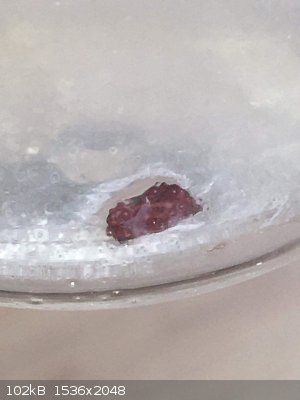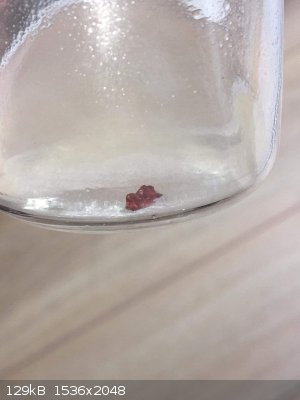vano
National Hazard
   
Posts: 661
Registered: 22-3-2019
Location: Georgia
Member Is Offline
|
|
Why samarium has red colour in selenous acid?
Hi, today i made some samarium selenite. I had small amount of samarium hydroxide and selenous acid solution. I dissolved hydroxide in excess acid and
next i added samarium metal and it turned red.
 
|
|
|
unionised
International Hazard
    
Posts: 5102
Registered: 1-11-2003
Location: UK
Member Is Offline
Mood: No Mood
|
|
You have produced the Sm2+ ion which is red.
I know that the sulphate is insoluble; perhaps the selenite is too.
|
|
|
vano
National Hazard
   
Posts: 661
Registered: 22-3-2019
Location: Georgia
Member Is Offline
|
|
I thought too, but i have no idea what is reducing agent. I did not think that reducing samarium ion was so easy. From what I have seen Sm2+ compounds
are all much harder to make.
|
|
|
Texium
Administrator
       
Posts: 4508
Registered: 11-1-2014
Location: Salt Lake City
Member Is Offline
Mood: PhD candidate!
|
|
The samarium metal is the reducing agent. It’s similar to how you can produce copper(I) compounds by reduction of copper(II) solutions with copper
metal.
|
|
|
vano
National Hazard
   
Posts: 661
Registered: 22-3-2019
Location: Georgia
Member Is Offline
|
|
Okay.What you say is interesting. but difference is solubility, in solution we always use soluble divalent salt of copper and samarium selenite is
Insoluble. But now i think it is possible that some Selenite are dissolved in slightly acidic solution, because at first i used excess acid that it
why i added metal. I think this opinion is the most accurate.
[Edited on 17-4-2021 by vano]
|
|
|
woelen
Super Administrator
        
Posts: 7976
Registered: 20-8-2005
Location: Netherlands
Member Is Offline
Mood: interested
|
|
I remember that I added samarium metal to some dilute acid (e.g. HCl) and that the solution had a strong color (intensely yellow/ochre, not red),
which quickly faded to nearly colorless. The metal formed strongly colored samarium(II), which quickly was converted to samarium(III).
In your situation, I think that the samarium metal reacts with selenite, giving red elemental selenium. IIRC europium(II) ion is dark red, while
europium(III) ion is colorless. Samarium(II) is yellow, not red.
|
|
|
unionised
International Hazard
    
Posts: 5102
Registered: 1-11-2003
Location: UK
Member Is Offline
Mood: No Mood
|
|
"Samarium is one of the few lanthanides that exhibit the oxidation state +2. The Sm2+ ions are blood-red in aqueous solution"
From
https://en.wikipedia.org/wiki/Samarium
And my experience of making it- by dissolving Samarium in dilute acid- confirms this.
|
|
|
Bedlasky
International Hazard
    
Posts: 1219
Registered: 15-4-2019
Location: Period 5, group 6
Member Is Offline
Mood: Volatile
|
|
Quote: Originally posted by unionised  | You have produced the Sm2+ ion which is red.
I know that the sulphate is insoluble; perhaps the selenite is too. |
Sm2+ in aqueous solution? No way, Sm2+ react with water to produce Sm3+ and hydrogen. Sm2+ is often prepared in THF from Sm metal and iodine.
Quote: Originally posted by woelen  | I remember that I added samarium metal to some dilute acid (e.g. HCl) and that the solution had a strong color (intensely yellow/ochre, not red),
which quickly faded to nearly colorless. The metal formed strongly colored samarium(II), which quickly was converted to samarium(III).
In your situation, I think that the samarium metal reacts with selenite, giving red elemental selenium. IIRC europium(II) ion is dark red, while
europium(III) ion is colorless. Samarium(II) is yellow, not red. |
Sm(II) is red, Sm(III) is yellow.
|
|
|
vano
National Hazard
   
Posts: 661
Registered: 22-3-2019
Location: Georgia
Member Is Offline
|
|
I agree with Bedlasky. Getting a samarium 2+ is much harder, so I hesitate. It should also be noted that it had a red color before I heated the
solution, ie the color did not disappear immediately after formation. But so far I still believe in the above, because I have no other better option.
|
|
|
vano
National Hazard
   
Posts: 661
Registered: 22-3-2019
Location: Georgia
Member Is Offline
|
|
Quote: Originally posted by woelen  |
In your situation, I think that the samarium metal reacts with selenite, giving red elemental selenium. IIRC europium(II) ion is dark red, while
europium(III) ion is colorless. Samarium(II) is yellow, not red. |
I think it has red colour. Also how samarium can react with selenite ion to produce selenium? Not selenium but Once i turned selenite to selenide. I
used cobalt selenite dihydrate and reducing agent thiosulfate.
|
|
|
unionised
International Hazard
    
Posts: 5102
Registered: 1-11-2003
Location: UK
Member Is Offline
Mood: No Mood
|
|
How did you come to the conclusion that calling me a liar was a good idea?
|
|
|
Texium
Administrator
       
Posts: 4508
Registered: 11-1-2014
Location: Salt Lake City
Member Is Offline
Mood: PhD candidate!
|
|
Neither of you are wrong.
Samarium(II) does reduce water to hydrogen, but it's not instantaneous, and the ion is red in solution when it exists transiently. Not all
samarium(II) compounds are red though. Samarium(II) iodide, the most commonly encountered salt, is dark green. I've seen fresh ampoules of it, and it was a very dark green, crystalline
powder. Yet, this old article from 1953 says that all samarium(II) compounds, except for an insoluble green carbonate that they observed, are red-brown,
including the iodide. The paper also confirms that insoluble samarium(II) compounds that they prepared, including the sulfite, which is likely to be
analogous to the selenite, were stable when suspended in water, though they decomposed upon drying. I'd be very interested to learn more about this
discrepancy of colors...
[Edited on 4-18-2021 by Texium (zts16)]
|
|
|
Bedlasky
International Hazard
    
Posts: 1219
Registered: 15-4-2019
Location: Period 5, group 6
Member Is Offline
Mood: Volatile
|
|
I don't say that you are liar. I say that Sm(II) isn't stable in aqueous solution. Read it again.
Texium: Solutions of SmI2 are red. I didn't know that solid is green, interesting.
[Edited on 18-4-2021 by Bedlasky]
|
|
|
vano
National Hazard
   
Posts: 661
Registered: 22-3-2019
Location: Georgia
Member Is Offline
|
|
Sometimes it appears to be green, though sometimes it has a black color and is more difficult to notice green colour. Of course it just depends on the
seller.
https://chemcraft.su/product/24915
https://onyxmet.com/index.php?route=product/product&prod...
|
|
|
unionised
International Hazard
    
Posts: 5102
Registered: 1-11-2003
Location: UK
Member Is Offline
Mood: No Mood
|
|
Ok, I read it again.
In particular I read this bit.
"Sm2+ in aqueous solution? No way, "
Do you accept that you are simply wrong, that Sm++ exists in solution and your "no way" claim is daft?
|
|
|
woelen
Super Administrator
        
Posts: 7976
Registered: 20-8-2005
Location: Netherlands
Member Is Offline
Mood: interested
|
|
I have some 99.95% samarium, intended as sample for my element collection, but half of it is oxidized and covered in a thick layer of Sm2O3 (pale
yellow powder) 
I decided to salvage the metal from this (ugly looking pieces, covered in dust, soft long needles of metal) and added some of this to dilute HCl. You
indeed get a deep red solution, but it seems not to be completely clear. Once all metal is gone, the liquid almost instantly loses its red color and
it also becomes clear and a pale yellow color remains.
So, I was wrong in my previous post. I remember reading something about a strong yellow color, but maybe that is Eu(2+) instead of Sm(2+).
____________________________________________________
But still, the persisting red color in your experiment could be elemental selenium. You can find out easily if you add water to the solution.
Samarium(II) ions very quickly will lose their color, while elemental selenium does not change on addition of some water.
|
|
|
vano
National Hazard
   
Posts: 661
Registered: 22-3-2019
Location: Georgia
Member Is Offline
|
|
Good idea, but now i have 1,5 g of samarium and i can't waste this for this experiment. But i can definitely say that red colour disappeared when i
heated solution. Once i made indium selenite in test tube. I didn't save this, so first i used indium nitrate and selenium contaminated product, but
selenium particles didn't disappeared and final product had white radish colour. I cant understand why would selenium disappear from the solution. In
the case of sulfur(thiosulfate) this is possible but selenoselenate is not exist.
|
|
|
Boffis
International Hazard
    
Posts: 1836
Registered: 1-5-2011
Member Is Offline
Mood: No Mood
|
|
The red colour is elemental selenium deposited on the surface of the samarium metal. Most any metal that will dissolve in dilute mineral acid will
deposit selenium from a selenite/selenous acid solution. No mystery, no Sm2+ just Se. The fine grained reduced ppt is deep red.
|
|
|
vano
National Hazard
   
Posts: 661
Registered: 22-3-2019
Location: Georgia
Member Is Offline
|
|
Interesting. Not samarium, but i can use other metals, you just say which is better. Also do you have any other information? Because I'm interested
in.
[Edited on 18-4-2021 by vano]
|
|
|
ChemTalk
Hazard to Self
 
Posts: 65
Registered: 13-12-2018
Location: United States
Member Is Offline
Mood: colloidal
|
|
Interesting thread. Yesterday we made some samarium sulfate from elemental samarium and sulfuric acid. The reaction was slow, and we had to add more
water to keep it going. Before we added the additional water, we saw a good amount of yellow samarium sulfate. It is very sparingly soluble in water.
When we added more water, most of it dissolved, and the pieces of remaining samarium metal started to again react and release hydrogen.
So we we have a test tube full of dilute sulfuric acid and a suspension of yellow samarium sulfate precipitate. And even smaller pieces of samarium
metal at the bottom.
I am gong to try adding some zinc and magnesium pieces, and perhaps some other reducing agents, to see if I can get the insoluble red samarium (II)
sulfate to form, which is supposed to be stable. But I won't hold my breathe 
In an inorganic synthesis book, they used sodium amalgam as a reducing agent, which unfortunately I don't have.
[Edited on 6-9-2021 by ChemTalk]
|
|
|
vano
National Hazard
   
Posts: 661
Registered: 22-3-2019
Location: Georgia
Member Is Offline
|
|
Quote: Originally posted by ChemTalk  | Interesting thread. Yesterday we made some samarium sulfate from elemental samarium and sulfuric acid. The reaction was slow, and we had to add more
water to keep it going. Before we added the additional water, we saw a good amount of yellow samarium sulfate. It is very sparingly soluble in water.
When we added more water, most of it dissolved, and the pieces of remaining samarium metal started to again react and release hydrogen.
So we we have a test tube full of dilute sulfuric acid and a suspension of yellow samarium sulfate precipitate. And even smaller pieces of samarium
metal at the bottom.
I am gong to try adding some zinc and magnesium pieces, and perhaps some other reducing agents, to see if I can get the insoluble red samarium (II)
sulfate to form, which is supposed to be stable. But I won't hold my breathe 
In an inorganic synthesis book, they used sodium amalgam as a reducing agent, which unfortunately I don't have.
[Edited on 6-9-2021 by ChemTalk] |
interesting. I can try a similar thing on Samaritan selenite, but I know nothing about divalent compound stability. Can you tell me which book did you
used?
|
|
|